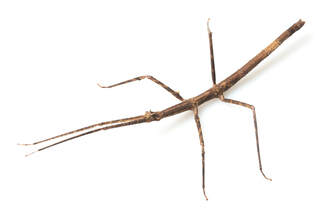Vietnamese Walking Sticks (Medauroidea extradentata)

Common Name: Vietnamese Walking Sticks
Scientific Name: Medauroidea extradentata1
Physical Description: Vietnamese Walking Sticks are approximately 4-5 inches in length. They are brown or green in color. They have long thin bodies with six legs and two small antennae on the head. The front two legs are used as “feelers” and are often held in front of the body. Their heads are elongated and oval shaped with thread-like antennae. Their chewing mouthparts are specially adapted for eating plant material. Along its thorax are a number of small, pointed bumps.
Vietnamese Walking Sticks do not have wings. Due to specialized structures on their feet, they can climb straight up vertical surfaces. Walking sticks are arboreal, spending the great majority of their lives in trees. Trees provide food for these insects and serve as their shelter.
To avoid being seen, walking sticks often feed at night and can remain completely motionless all day.
Young Vietnamese Walking Sticks can regenerate legs that have come off or that have been damaged, but adults cannot.
Habitat: They reside in the trees of tropical rainforests.
Range: They are native to Vietnam.
Diet: They are herbivores. They eat plant material.
Lifespan: Vietnamese Walking Sticks live on average 6 months in the wild and up to a year in human care.
Social Structure: Vietnamese Walking Sticks reproduce both sexually and asexually (meaning that they do not need a mate to reproduce). This makes males very rare in the species. The female drops hundreds of eggs onto the forest floor and leaves them unattended. The eggs hatch in 2 to 6 months. Eggs produced via mating hatch sooner than eggs produced by asexual reproduction. The eggs of this species are mottled with black and white and capped with black. Nymphs look nearly identical to adults except in size. They molt about 6 times before they become adults. At 3 months of age, they reach adult size and are able to reproduce.
Status: Not Listed
Other: Vietnamese Walking Sticks are part of the order Phasmatodea, which comes from the Latin word “phasma.” This word means, “ghost” and describes the remarkable ability of these insects to hide unseen by their predators. The Vietnamese Walking Stick’s ability to camouflage is its best defense against predators. If they encounter a predator, walking sticks extend their front legs straight out past their heads and remain completely motionless to help them blend in with the branch they are standing on.
1 https://journals.plos.org/plosone/article?id=10.1371/journal.pone.0007223
Scientific Name: Medauroidea extradentata1
Physical Description: Vietnamese Walking Sticks are approximately 4-5 inches in length. They are brown or green in color. They have long thin bodies with six legs and two small antennae on the head. The front two legs are used as “feelers” and are often held in front of the body. Their heads are elongated and oval shaped with thread-like antennae. Their chewing mouthparts are specially adapted for eating plant material. Along its thorax are a number of small, pointed bumps.
Vietnamese Walking Sticks do not have wings. Due to specialized structures on their feet, they can climb straight up vertical surfaces. Walking sticks are arboreal, spending the great majority of their lives in trees. Trees provide food for these insects and serve as their shelter.
To avoid being seen, walking sticks often feed at night and can remain completely motionless all day.
Young Vietnamese Walking Sticks can regenerate legs that have come off or that have been damaged, but adults cannot.
Habitat: They reside in the trees of tropical rainforests.
Range: They are native to Vietnam.
Diet: They are herbivores. They eat plant material.
Lifespan: Vietnamese Walking Sticks live on average 6 months in the wild and up to a year in human care.
Social Structure: Vietnamese Walking Sticks reproduce both sexually and asexually (meaning that they do not need a mate to reproduce). This makes males very rare in the species. The female drops hundreds of eggs onto the forest floor and leaves them unattended. The eggs hatch in 2 to 6 months. Eggs produced via mating hatch sooner than eggs produced by asexual reproduction. The eggs of this species are mottled with black and white and capped with black. Nymphs look nearly identical to adults except in size. They molt about 6 times before they become adults. At 3 months of age, they reach adult size and are able to reproduce.
Status: Not Listed
Other: Vietnamese Walking Sticks are part of the order Phasmatodea, which comes from the Latin word “phasma.” This word means, “ghost” and describes the remarkable ability of these insects to hide unseen by their predators. The Vietnamese Walking Stick’s ability to camouflage is its best defense against predators. If they encounter a predator, walking sticks extend their front legs straight out past their heads and remain completely motionless to help them blend in with the branch they are standing on.
1 https://journals.plos.org/plosone/article?id=10.1371/journal.pone.0007223






